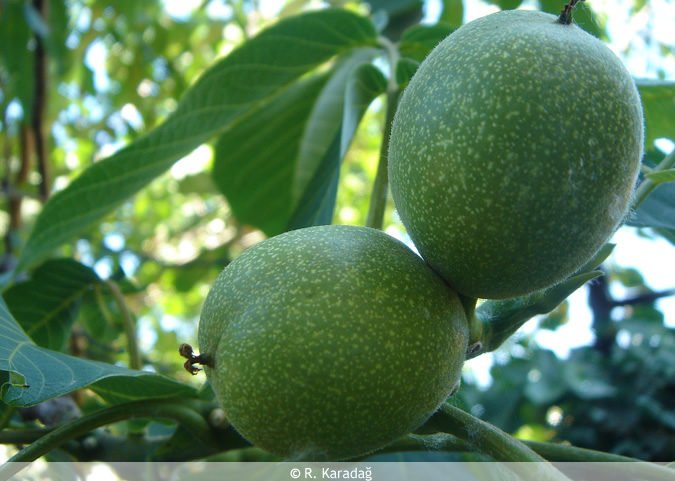The deciduous tree can grow to 100 feet , and as the name regia says, it is truly a king among trees. It has unisexual flowers that are pollinated by the wind. The male flowers are catkins that hang on the twigs from the previous year. The female flowers grow in twos or threes at the ends of new twigs. The fruit nuts have a green, pulpy husk that splits to free the ripe nut. The Balkans, Asia Minor and the Middle East are the home of Juglans regia. In the rest of Europe , the tree has become common. It does not survive hard winters well.Historical Data
In Turkey and other countries in the temperate zone in both the New and the Old World , there is only one significant dyeplant for brown: the more than twenty species of the walnut family, Juglans. The outer husks of the nuts and the leaves have been used since ancient times to produce a brown dye. In antiquity, Greek and Roman writers mentioned the cultivation of walnut trees. Pliny gives a recipe for dyeing grey hair to brown. The Romans brought the tree from Greece to Italy and later across the Alps, first to France , then to Germany . From the expression Welsh nut (foreign nut), in both English and German, the names walnut and Walnuss developed. Many sources report its use as a brown dye for wool. Use of the dried husks for dyeing continues to this day in Turkey , Iran , and other countries, where the husks are sold for this purpose.Classical Turkish carpets from the 15th to 17th centuries, however, and in contrast to Persian carpets from that period, contain almost no walnut-brown. The dyeing of wool with the nut husk and iron mordant is appreciated for its beauty and since the beginning of the art of dyeing in Persia , and the dyeing with various parts of the tree has been practised in all the countries. In Europe , the nut husk and the barks and roots were one of the basic ingredients of dyeing in Middle Ages. In the 17th century, Colbert was developed French textile industry, classified the walnut tree among the sources of dyeing materials. This dyeing was systematically used in Europe , not only in drapery but also in all of the tapestry production centres. During the American Civil War (1861-1865) and the Turkish Independence War (1919-1922), the uniforms of the soldiers were dyed with walnut.In Turkish village rugs, it is seldom found. Apparently the colour was not found to be attractive. In North America , the black walnut tree, Juglans nigra , is endemic and can reach to 135 feet .

